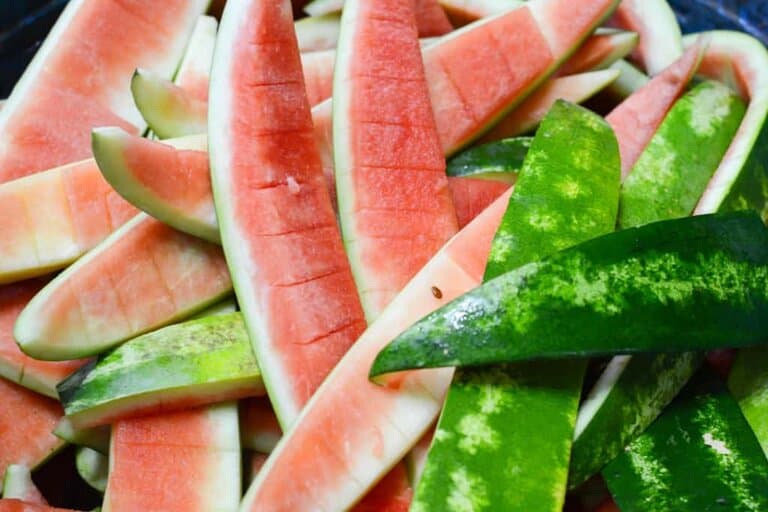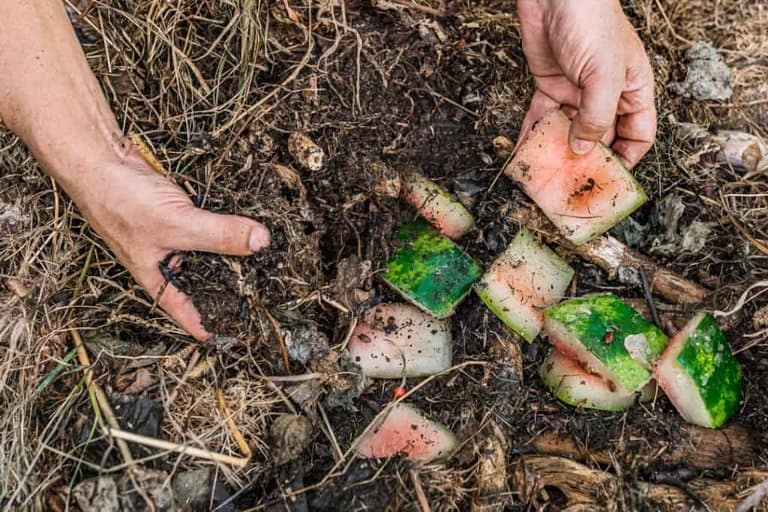Watermelon rinds don’t belong in garbage disposals because they are hard, rubbery, and detritus. They can damage the blades of the disposal unit if they are clogged. It is best to put watermelon rinds in trash cans or use them for compost.
Garbage disposal has become a second garbage can in many homes. I know how it feels to want to dump all the kitchen-generated waste into the garbage disposal and let it do all the work for you.
The truth is that garbage disposals are not meant for all kinds of waste, and the source of this confusion may be the name. Contrary to what you might think, the garbage disposal is a sensitive piece of machinery.

Why You Shouldn’t Put Watermelon Rinds Down Garbage Disposal
Many food products should not go down your garbage disposals, such as rubbery or fibrous foods, tough meat, bones, and other hard food detritus. Watermelon rinds fall into the category of hard food detritus.
When hard food detritus is tangled in the impellers of your disposal, it is really hard for the disposal to grind it up. Putting the watermelon rinds may harm the lugs and overheat the disposal motor.
They may also get stuck in the system for a long time, causing the disposal to malfunction.
How Garbage Disposals Work
You may see garbage disposals as high-powered, sharp-bladed machines capable of crushing any waste material into a paste, but that is incorrect. There is a metal chamber within the machine with a circular plate containing two swiveling metal lungs called impellers.
This mechanism is driven by a motor underneath it that pulverizes the food waste into a paste and leads it into the pipes. Pouring the wrong things into the disposal may wear out the impellers or wind around the machinery and damage the motor.
What To Do With Watermelon Rinds
Method 1: Dispose Into A Trash Can
The simplest way to dispose of fruit waste like watermelon rinds is to use the trash can. It does not cause any harm to your environment and can be disposed of through the appropriate quarters. Place the rinds in a disposable nylon bag or trash can.
Method 2: It Can Be Eaten Raw
Although many people are not predisposed to eating watermelon with its green hardback, the rind is actually edible. Just like cucumbers, you can eat every part of the watermelon except the seeds.
It contains fiber and many other benefits like reducing blood pressure, improved libido, etc. So the next time you feel like troubling your garbage disposal with the rinds, it is healthier, safer, and more convenient just to eat them.
Method 3: Feed Them To Pets
Watermelon is a good source of nutrition and can be fed to pets. Remember to remove the seeds from the flesh before feeding your cat or dog, and they can eat the fruit whole.
Method 4: Use Them For Plant Composting

Watermelon rinds are a great source of compost for gardens and farms. It is a rich source of green matter and other healthy vitamins for plants. It contributes a good amount of nitrogen, phosphorus, and moisture to the soil.
It takes about 35 days for watermelon rinds to completely decompose, which is good for the soil. Watermelon seeds can also be used as compost. You can cut the watermelon rinds into smaller bits or blend them into a paste to speed up the composting process.
Method 5: Add To A Recipe
Watermelon rinds can be a great ingredient in making delicious meals. They can be chopped up and mixed in a salad. They can be added to a cucumber-drill salad, made into a herb slaw, or mixed into a cold soup. The rinds can be blended to make a smoothie and can be paired with almost any fruit.
Fruits That Can Be Placed In Garbage Disposal
Although fruits rinds and pits, in general, should not be placed in garbage disposals, there are a few exceptions to this rule.
Orange peels clean out residue and other stuck food waste. It also gets rid of the foul smell and gives your kitchen a fresh scent. Cut up the orange peels into smaller bits and run water before, during, and after the peels are poured.
Remember to always remove the tag from fruits before disposing of the rinds in the garbage disposal. They tend to stick to the insides of pipes or the disposal blades, which is not advisable.
3 Food Waste That Should Not Be Put In Garbage Disposal
Here is a list of food waste that you should not put into the garbage disposal:
Cooked Meat/Bones
Pouring strong meat that has bones down the drain into the disposal is a terrible idea. The garbage disposals are not designed to break down substances like bones and other hard materials. This may damage the disposal completely.
Grease
Grease and oil from frying cool down and clog up when they get into the garbage disposal. Every food material you place into the disposal will stick to the thick grease sludge until the whole system is blocked. The grease weighs down the motors until it causes damage.
Pasta
It is a well-known culinary fact that Pasta swells when exposed to moisture or water. If you get pasta down the garbage disposal, the impellers may find it difficult to grind it effectively, leaving residue. When water flows down the sink, as it always does, the pasta residue swells and causes a blockage in the system.
FAQs About Watermelons and Garbage Disposals
Are Watermelon Rinds Poisonous?
No, watermelon rinds are perfectly healthy to eat. They are water-logged protection for the fruit’s flesh and be consumed in different ways.
Can I Put Avocado Pits In My Garbage Disposal?
Avoid outing avocado pits or any other kind of pit into garbage disposals. They are much too hard for the disposal system to break down and would only wear down the motor.